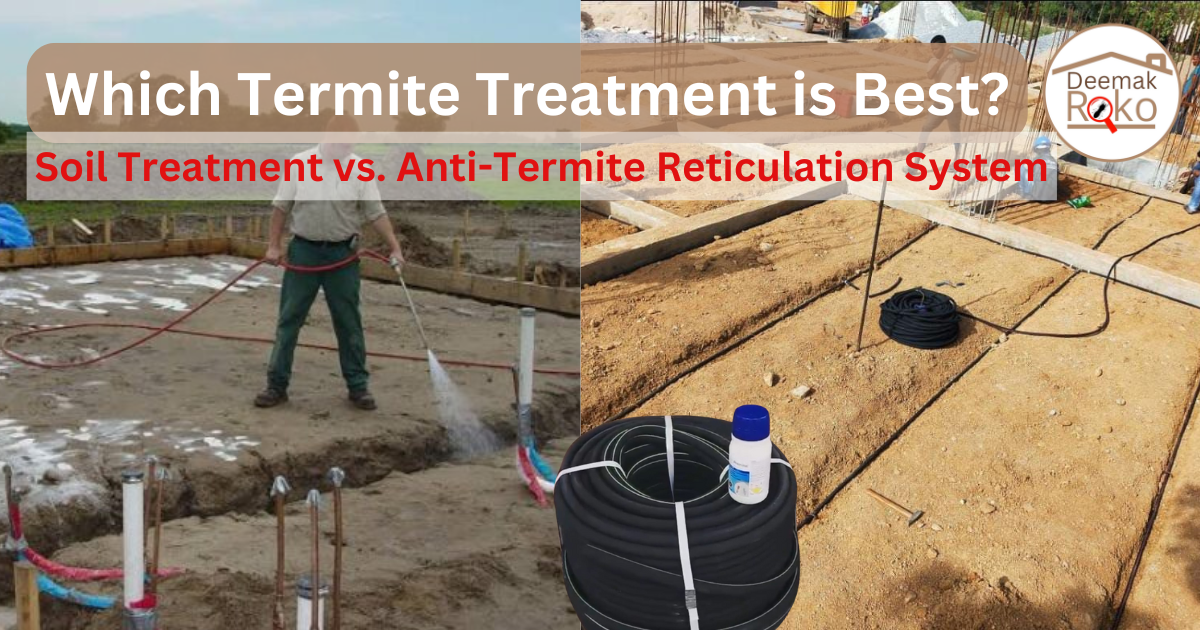Which Is the Best Termite Solution? Soil vs. Reticulation
Termites can cause severe damage to your property, making termite control a top priority for homeowners and businesses. With various termite solution options available, it’s essential to choose the most effective one. The two most popular methods are soil treatment and the anti-termite reticulation system. The combination of both methods ensures long-term and comprehensive protection against termites. In this guide, we will compare both methods to help you make an informed decision on the best termite solution for your property.
Understanding Termite Control Methods
What is Soil Treatment?
Soil treatment is a traditional method of termite control that involves applying liquid termiticides to the soil surrounding a structure. This creates a chemical barrier that prevents termites from entering the building.
How Soil Treatment Works
- Professionals dig trenches around the foundation and apply termiticides.
- The treated soil acts as a shield against termites.
- Over time, the chemicals break down and may require reapplication.
Pros and Cons of Soil Treatment
- Quick and effective termite control.
- Works for pre- and post-construction treatment.
- Lower initial cost compared to reticulation systems.
- Requires reapplication as chemicals degrade over time.
- May involve more chemical exposure to the environment.
What is an Anti-Termite Reticulation System?
An anti-termite reticulation system is a network of underground pipes installed around a building’s foundation. These pipes allow termiticides to be distributed evenly, offering long-term protection with periodic refilling.
- Pipes are installed before construction or around existing structures.
- Chemicals are injected through the pipes at regular intervals.
- This system ensures even and precise distribution of termiticides.
Pros and Cons of Reticulation Systems
- Provides long-term protection with easy re-treatment.
- More eco-friendly as chemicals are applied in a controlled manner.
- Requires minimal disruption for reapplication.
- Higher initial installation cost but cost-effective over time.
- Best suited for new constructions.
Key Differences: Soil Treatment vs. Reticulation System
Factors
Installation
Effectiveness
Maintenance
Cost
Eco-Friendliness
Soil Treatment
Direct application to soil
Immediate but may degrade
Requires reapplication
Lower initial cost
May involve more chemicals
Reticulation System
Network of pipes installed underground
Long-term, re-treatable system
Simple, periodic refilling
Higher initial cost but cost-effective over time
Controlled and precise application
Which Termite Solution is Best for Your Property?
Choosing between soil treatment and a reticulation system depends on several factors. However, using both methods together ensures maximum termite protection.
- For new construction: The anti-termite reticulation system is a better choice because it provides long-term protection with easy re-treatment. However, pairing it with soil treatment offers an added layer of security.
- For existing buildings: Soil treatment is a quicker and more affordable option, but adding a reticulation system enhances its effectiveness.
- Budget considerations: While soil treatment costs less initially, a reticulation system may save money in the long run due to its efficient re-treatment process.
- Environmental impact: Reticulation systems are more eco-friendly, as they limit excessive chemical exposure.
Conclusion: Making the Right Choice
Both termite treatment methods offer effective protection, but the best approach is to use them together. Soil treatment with an anti-termite reticulation system, as the combination ensures long-term, low-maintenance, and comprehensive termite solution.
Consulting with a professional pest control expert can help you determine the best termite solution for your specific situation. Don’t wait until termites invade—take action today to safeguard your property!

